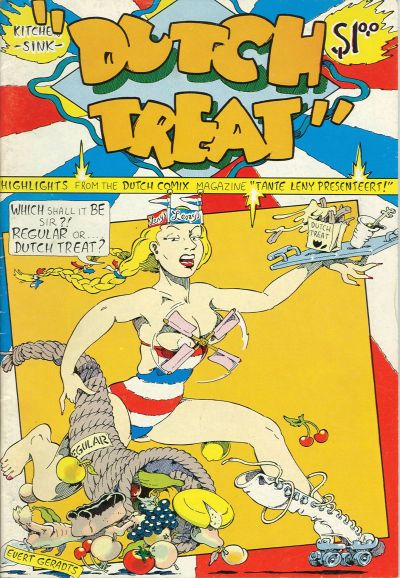Joost Swarte! Mark Smeets! Bill Bodéwes! Harry Buckinx! Ever Meulen! Peter Pontiac! Aart Clerkx! Evert Geradts! ‘Tante’ Leny Zwalve! A cornucopia of Dutch underground artists you very likely won’t have heard of, except maybe Joost Swarte on display in this 1977 Kitchen Sink oneshot.

I got this at the Haarlemse Stripdagen in 2022 together with half a dozen other great underground comix from two elderly gentlemen selling their collection.
Underground comix are hard to define and really only existed for a decade and a half. Created, published and distributed outside of the existing commercial comics industry, the underground started off with a few pioneers self publishing their comic strips in the early sixties. By the end of the decade several publishers (Rip-off Press, Last Gasp and Kitchen Sink e.g.) were active and there was a distribution system centered on the socalled head shop. The underground comix movement always had firm ties to the whole sixties counter culture though it wasn’t quite part of it. It did however share its fascination with sex, drugs and rock ‘n roll, though mostly the first two. Even if often prurient, underground comix offered a freedom denied to the staid commercial comic, nobbled as it was by the Comics Code. As hippie idealism died off in the cold light of Nixon’s America and drugs repression put head shops out of business, the underground comix boom slowly collapsed but not without having inspired generations of new comics artists.
Sad to say, in the Netherlands at the time American comics were largely ignored, seen as pure pulp with no merit. The Franco-Belgian tradition was dominant and except for Disney there wasn’t really any place for American artists in the Dutch magazines. Even so there was what you could arguably call an underground movement by the late sixties and early seventies, partially coming out of rock zines like Aloha and with some ties to the radical hippie movement. It was through Olaf Stoops’ Real Free Press that American underground comix would be imported and more, it would also publish Dutch translations as well as original work from Dtch cartoonists. All of which led to the creation of Tante Leny Presenteert in 1971, created by Leny Zwalve and Evert Geradts.
Whether this was the “first Dutch underground comic” as the introduction page in Dutch Treat has it is debatable because at roughly the same time Joost Swarte had published his Modern Papier zine, which would later merge with Tante Leny and there had been some Real Free Press publications already if I’m not mistaken. (So much of the history of Dutch comics has not been written yet though so it can be hard to tell at this late date.) But it was certainly the longest running, ending in 1978 with twentyfive issues. And the people it published were some of the most influential cartoonists of the seventies and beyond.
Dutch Treat, as you can see from the table of contents, offers a good overview of the most important talents the zine published over the years. My personal favourites here are Joost Swarte with his darkly ironic clear line style and Peter Pontiac, here represented with a four pager showing off his gritty, realistic style of drawing. Also excellent is Evert Geradts’ “Crump meets Disney” big nosed art work. On the whole, if you want a good overview of what the Duitch underground scene was like, this is a great introduction.
No Comments